同时具备自修复和超疏水能力的集成式可穿戴协作应变传感器,用于稳定的传感监测
IF 6.9
2区 材料科学
Q1 MATERIALS SCIENCE, MULTIDISCIPLINARY
引用次数: 0
摘要
柔性可穿戴应变传感器在可穿戴设备、电子皮肤和环境监测领域具有广泛的应用前景。然而,由于机械损伤和液体腐蚀会导致局部降解、微裂纹甚至宏观裂纹,因此这些传感器在暴露于恶劣环境时要保持稳定的传感性能面临挑战。在本文中,我们介绍了一种集成可穿戴协作应变传感器(IWCSS),它是通过在导电双交联水凝胶表面应用超疏水层实现的。这种 IWCSS 一旦被切断,在 25 ℃ 下经过 16 小时后就能同时恢复其传感性能和超疏水性,这归功于可逆键--酰胺、硼酸酯和金属配位键--的协同效应推动了分子自愈合。此外,IWCSS 的传感系数为 0.8,响应时间为 70 毫秒,其超疏水层可以抵御水的渗透和腐蚀性液体的侵蚀,确保在恶劣环境中稳定传感并准确监测人体运动。我们的设计策略为开发在严苛工作环境中可靠性更高的可穿戴传感器材料铺平了道路。本文章由计算机程序翻译,如有差异,请以英文原文为准。
Integrated wearable collaborative strain sensor with simultaneous self-healing and superhydrophobic abilities for stable sensing monitoring
Flexible wearable strain sensors possess extensive applicability in wearables, electronic skin, and environmental monitoring. However, these sensors face challenges in maintaining stable sensing performance when exposed to harsh environments, as mechanical damage and liquid corrosion can lead to localized degradation, micro-cracks, and even macroscopic cracks. Herein, we present an integrated wearable collaborative strain sensor (IWCSS), achieved by applying the superhydrophobic layer on conductive double-cross-linked hydrogel surface. This IWCSS, once severed, can simultaneously restore its sensing performance and superhydrophobicity after 16 h at 25 ℃, attributing to the synergistic effect of reversible bonds—amide, borate ester and metal coordination bond—that drive molecular self-healing. Additionally, with a sensing coefficient of 0.8 and a response time of 70 ms, the IWCSS's superhydrophobic layer serves as a shield against aqueous infiltration and corrosive liquids, ensuring stable sensing and accurate monitoring of human movements in harsh environments. Our design strategy paves the way for developing wearable sensor materials with enhanced reliability in demanding operating environments.
求助全文
通过发布文献求助,成功后即可免费获取论文全文。
去求助
来源期刊

Applied Materials Today
Materials Science-General Materials Science
CiteScore
14.90
自引率
3.60%
发文量
393
审稿时长
26 days
期刊介绍:
Journal Name: Applied Materials Today
Focus:
Multi-disciplinary, rapid-publication journal
Focused on cutting-edge applications of novel materials
Overview:
New materials discoveries have led to exciting fundamental breakthroughs.
Materials research is now moving towards the translation of these scientific properties and principles.
 求助内容:
求助内容: 应助结果提醒方式:
应助结果提醒方式:


